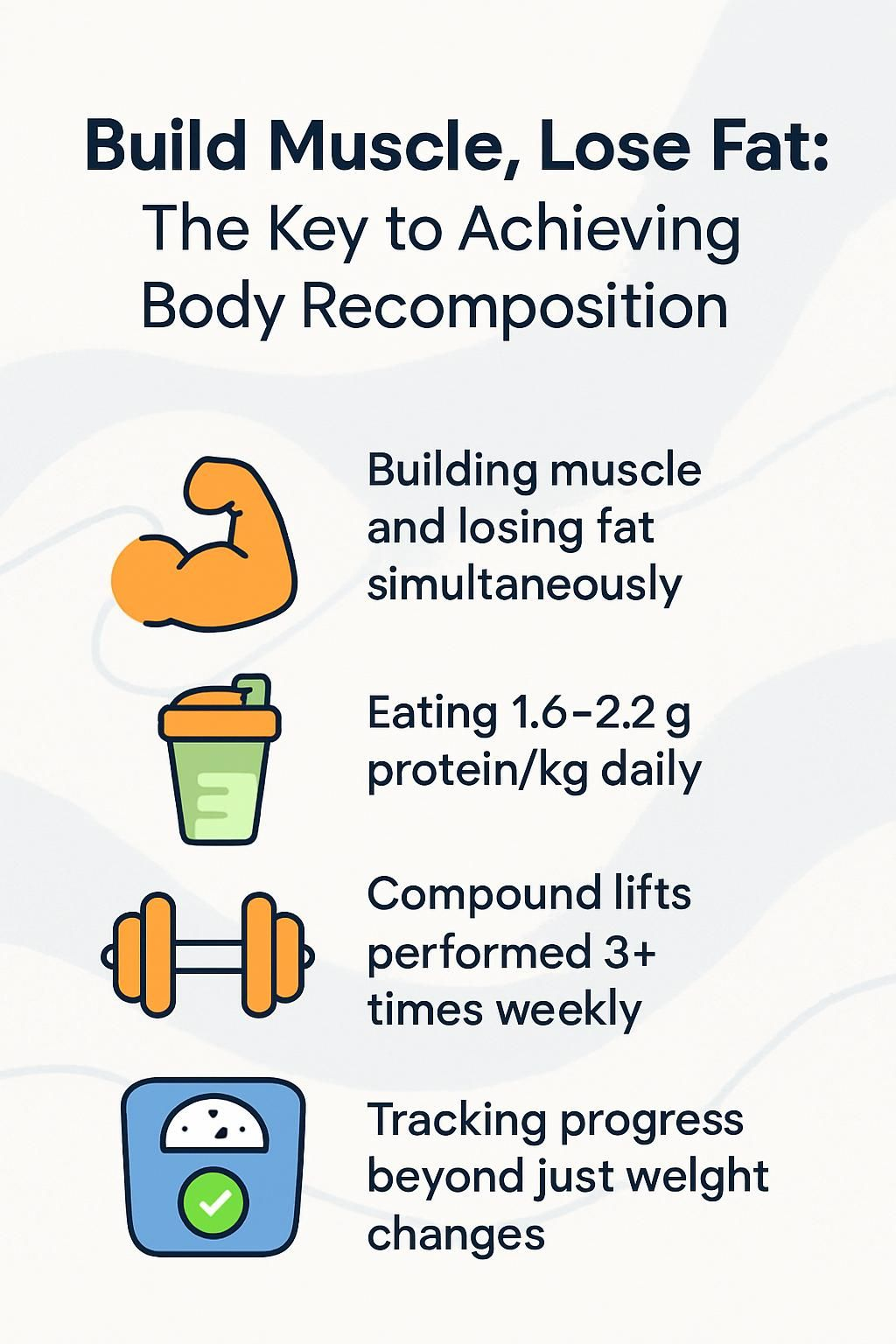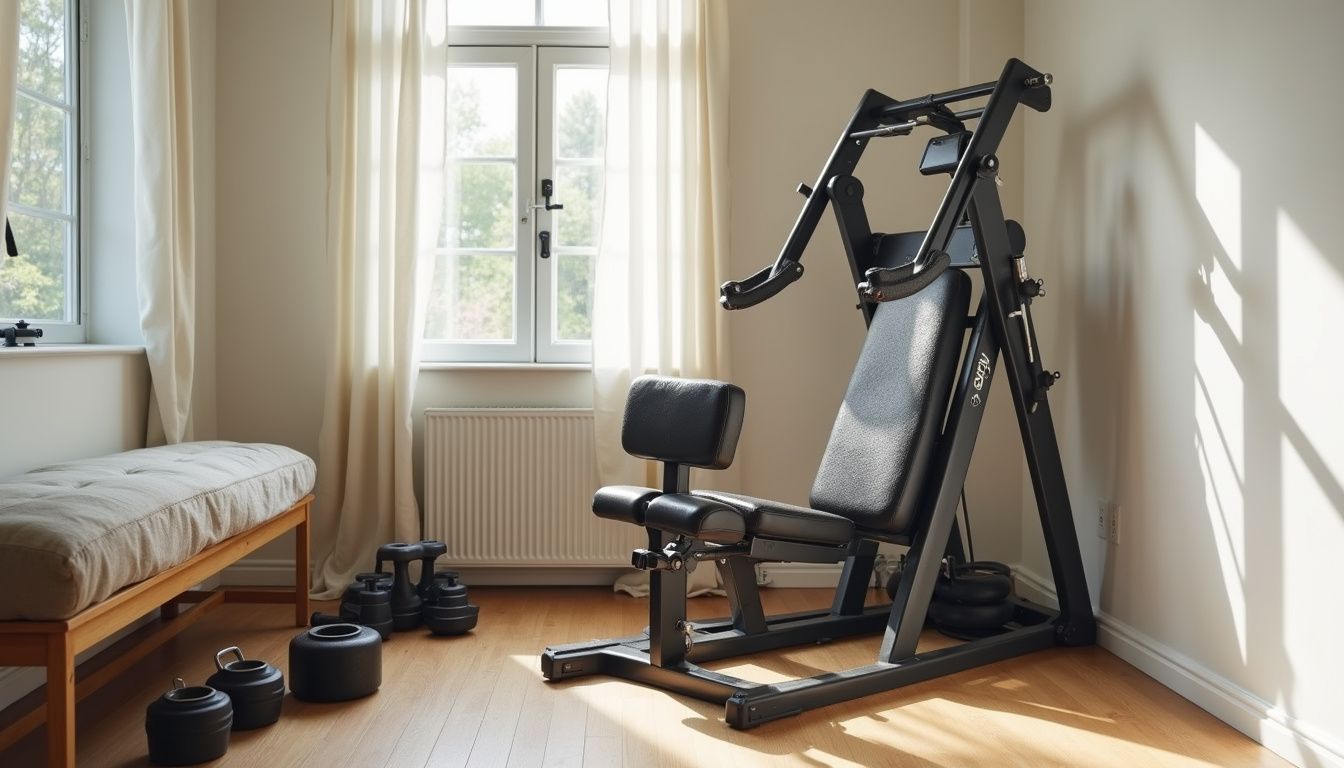Build Muscle, Lose Fat: The Key To Achieving Body Recomposition
Our Nutrition Assistant AI Suite will transform your body. You will lose fat, get toned, and build muscle. Gain confidence and optimal health.
Trying to lose fat and gain muscle at the same time can feel confusing. The good news is that body recomposition, changing the mix of muscle and fat, is possible with the right plan. Research suggests this approach improves health and appearance over simple weight loss.
This guide shows you how to build muscle while losing fat using evidence-based steps. You will learn how to set up your nutrition, choose a workout plan, and track progress without fixating on the scale.
1: Schoenfeld BJ et al., “Body Recomposition: Can You Lose Fat and Gain Muscle at the Same Time?,” Strength & Conditioning Journal, 2020.
Key Takeaways
- Body recomposition means gaining muscle and losing fat at the same time, often with little change on the scale (Schoenfeld BJ et al., 2020).
- Protein intake of 1.6 to 2.2 grams per kilogram of body weight per day, paired with regular resistance training, supports fat loss and muscle growth best.
- Compound lifts like squats, deadlifts, and bench presses at least three times per week drive faster strength and body composition changes than isolation moves (Kraemer WJ et al., 2020).
- Track more than weight: use DEXA scans, skinfolds, strength logs, photos, and tape measurements to monitor progress.
- Sleep at least seven hours and manage stress to reduce cortisol, which helps muscle repair and steady fat loss.

What Is Body Recomposition?

Body recomposition is the process of adding muscle while reducing fat. Your body can change shape and become firmer even if your weight stays about the same.
What does body recomposition mean?
Body recomposition means lowering body fat and increasing muscle mass at the same time. You change the ratio of fat to muscle, not just the number on the scale.
This approach uses strength training and smart nutrition to build new muscle tissue while slowly reducing stored fat. The result often shows up in how your clothes fit and how strong you feel.
For example, training three days per week with squats, bench press, and rows, along with a high protein diet, can reshape your physique. In my first eight weeks of tracking lean mass and body fat, my jeans fit looser while my arms looked more defined.
How is body recomposition different from just losing weight or gaining muscle?
Weight loss alone can remove both fat and muscle, especially with very low calories or lots of cardio without lifting. Pure muscle gain often comes with extra body fat if calories are too high.
Recomposition targets both goals at once. You keep calories near maintenance or slightly below, eat enough protein, and lift weights to support muscle growth while fat drops. This balance helps you look and perform better without losing strength.
Eating about 0.7 to 1 gram of protein per pound of body weight and training with lifts like squats, deadlifts, push-ups, or dumbbell presses supports muscle growth while trimming fat. During my first attempt, the scale barely moved, but DEXA results and how my jeans fit told the real story.
Focusing on how your clothes fit and how strong you feel beats watching the scale alone.
How Body Recomposition Works
Recomposition depends on energy balance and metabolism. Metabolism is how your body turns food into energy. You create a plan that nudges fat loss while giving muscles the signal and materials to grow.
How can you lose fat and gain muscle at the same time?
Use two pillars: a small calorie deficit and high protein intake. Randomized trials show 1.6 to 2.2 grams of protein per kilogram of body weight per day supports muscle growth and fat loss at once.
Combine that intake with resistance training three days per week. Think squats, pull-ups, and barbell presses. Your lifts stimulate muscle protein synthesis, the repair process that builds muscle. The small deficit encourages your body to use stored fat for energy.
Track body composition changes, not just weight. When I followed this setup in college, I added visible muscle in my arms and lowered body fat across six months, even though the scale barely moved.
What role do metabolism and energy balance play in body recomposition?
A higher basal metabolic rate, the calories you burn at rest, makes fat loss easier and helps maintain muscle. Energy balance is the difference between calories you eat and calories you burn through daily activity and body functions.
A slight calorie deficit reduces fat while resistance training and protein protect muscle. Many reviews find the best results come from combining lifting with careful calorie control. A protein range of 1.6 to 2.2 grams per kilogram of body weight supports muscle during fat loss.
Track your meals to steer toward a mild deficit when cutting or a slight surplus when building. That control helps you keep strength gains steady while your body composition improves.
“A steady plan for food and training drives lasting changes in lean mass and body composition.”
Once you understand energy balance, nutrition planning becomes far easier to manage day to day.
Nutrition for Body Recomposition
Nutrition shapes your results. The right calorie target and protein intake protect muscle, help you perform your workouts, and move you closer to your goal.
Why is calorie balance important for body recomposition?
Calorie balance sets the stage for change. A surplus adds weight, often fat. A large deficit can cause muscle loss along with fat loss.
For recomposition, aim for a small deficit or maintenance. A 2020 review found that pairing higher protein intake with resistance training helps maintain muscle in a deficit. This approach also supports bone health and lowers the risk of muscle loss with age.
Use a reputable calculator or sports nutrition guidance to estimate daily calories. Track your intake so weekly changes stay slow and steady, around one to two pounds per week at most. This pace supports health while protecting the strength you build with progressive overload.
How much protein do you need to build muscle and lose fat?
Aim for 0.7 to 1 gram of protein per pound of body weight daily. This range supports muscle recovery and growth during resistance training.
If you weigh 150 pounds, target 105 to 150 grams of protein per day. Good sources include eggs, dairy, lean meats, fish, tofu, beans, and nuts. Protein reduces hunger and helps control calories, which supports fat loss.
Peer-reviewed studies show protein helps people with excess weight and those seeking better body composition. Spread protein across meals to support your metabolism while you reduce fat.
When and how often should you eat for best results?
Space your meals to deliver steady nutrients. Eating every three to four hours helps support protein synthesis, the process that builds muscle, and keeps hunger in check.
Most people do well with three meals and two protein-rich snacks, such as yogurt, a shake, or nuts. Pair carbohydrates with meals to fuel training and refill glycogen, the stored form of carbs in muscle. Include a protein source within an hour after workouts to support recovery.
Consistent meal timing also supports hormones that affect metabolism. It can make sticking to your plan during a recomposition phase much easier.
Best Exercises for Building Muscle
Resistance training drives muscle growth. The key is a strong training stimulus, enough recovery, and steady increases in challenge.
How does resistance training help build muscle?
Lifting weights or doing bodyweight training signals your muscles to grow. Exercise creates tiny tears in muscle fibers. With rest and protein, your body repairs these fibers so they come back stronger.
Training at least three days per week improves results and health. Compound movements like the squat, bench press, and row work many muscles at once, which makes your time in the gym more effective.
Progress by adding weight, reps, or sets over time. Start with simple moves like dumbbell curls and calf raises, then build toward heavier compound lifts as your form improves.
Next, take a closer look at the best compound lifts for growth and strength.
What are the best compound movements for muscle growth?
Compound exercises train multiple muscle groups, so they deliver more payoff per set. They also help your body burn more calories during training.
Core lifts include the squat, deadlift, bench press, overhead press, barbell or dumbbell row, and pull-up or lat pulldown. These target large muscles like quads, hamstrings, chest, back, triceps, and shoulders.
Big multi-joint lifts often trigger stronger hormonal responses than isolation moves such as curls or chest fly. In high school, I trained three days per week with a coach. Squats and presses grew my size and strength faster than workouts focused only on small muscles.
If your goal is efficient recomposition, emphasize compound moves and use isolation work as support.
…
^1^: Kraemer WJ et al., “Hormonal responses and adaptations to resistance exercise and training,” Sports Medicine (2020).
When should you use isolation exercises?
Use isolation exercises to bring up specific muscles that need attention. Examples include biceps curls or chest fly. These help fix imbalances, improve symmetry, and support rehab after injury.
They are also useful for shaping a lagging area while your main focus stays on compound lifts. During a 2022 prep cycle, I added isolation work three days per week. My arm definition improved while squats and bench press handled most of the heavy lifting.
Include isolation work to fine-tune your physique or correct weak points that limit your main lifts.
Exercises to Promote Fat Loss
Cardio helps you create a calorie deficit and supports heart health. Mix these methods with lifting so you keep muscle while dropping fat.
How does high-intensity interval training (HIIT) aid fat loss?
HIIT uses short bursts of hard effort followed by brief rests. It raises your heart rate quickly and burns many calories in less time than steady cardio.
During intense work, you burn glycogen, the stored form of carbs. After the session, your body continues to burn more energy, a process called EPOC, or excess post-exercise oxygen consumption. Studies show HIIT can reduce body fat while preserving muscle.
You do not need special gear. Treadmills, bikes, or a track will work. I used simple sprints three days per week and noticed looser clothes within a month.
One study found up to a 9 percent drop in body fat over 12 weeks with HIIT, even without big diet changes. It also improves markers linked to obesity risk.
What benefits does steady-state cardio offer for fat burning?
Steady-state cardio keeps a moderate pace for 30 to 60 minutes, like jogging or cycling. Your heart rate stays stable, often in a zone that uses more fat for fuel.
Training near 65 percent of your max heart rate encourages your body to rely on fat. Since the intensity is lower than HIIT, it is easier to repeat several times per week and is friendly to joints.
Combine steady cardio with lifting and a whole-food diet. Many people prefer this method because it feels gentle, yet it supports long-term weight control and complements muscle building.
How can circuit training help reduce body fat?
Circuit training moves you from one exercise to the next with short rests. This keeps your heart rate up and burns more calories than traditional lifting with long breaks.
A 155-pound person may burn around 298 calories in 30 minutes of circuit work. You also train many muscles at once, which can elevate calorie burn after the workout ends.
In my plan, mixing push-ups, squats, and jump rope three days per week improved fitness and trimmed my waist within two months. Circuit training builds work capacity while you preserve muscle.
The Role of Progressive Overload
Progressive overload means increasing challenge over time. This steady push is the signal your body needs to grow muscle and keep burning fat.
Why should you adapt your workouts over time?
Your body adapts to repeated stress. If your plan never changes, progress slows or stops. Studies from groups like ACSM show that updating the plan keeps growth and fat loss moving.
Ways to progress include increasing weight, adding sets, changing reps, or rotating exercises. For example, add a small amount of weight or an extra set during your three weekly sessions to spark new gains.
As lifts become easier, you know it is time to adjust. I track each session in a simple log. When the numbers stall, I make a small change so progress resumes while avoiding overuse injuries.
…
[1] American College of Sports Medicine (ACSM). “Progressive Overload Principle in Strength Training.”
How can you track strength and performance progress?
Log your weight, sets, and reps for every exercise. A notebook or app works fine. Over weeks, look for steady increases in weight lifted or reps completed with good form.
Test basic movements on a schedule, such as squats, push-ups, or deadlifts. Set clear goals like adding five pounds or two extra push-ups each month. Consistent increases signal that your program is working.
I measured success through weekly logs. Small wins like one extra rep or a slightly higher box jump kept me engaged even when visual changes were slow. Photos and tape measurements can highlight progress that the scale misses.
Importance of Recovery
Recovery is where your muscles repair and grow. Good sleep, stress control, and hydration support both muscle building and fat loss.
How does sleep affect muscle repair and fat loss?
Sleep is when your body releases growth hormone and carries out repairs after lifting. Poor sleep slows protein synthesis, the process that builds new muscle, and reduces performance in the gym.
Lack of sleep also disrupts hunger hormones like ghrelin and leptin. That tends to increase cravings and calorie intake. People sleeping under seven hours per night face higher risks of weight gain and high blood pressure.
On nights I slept only five hours, my hunger jumped and workouts dragged. Better sleep made training smoother and fat loss more consistent.
What are effective active recovery techniques?
Light movement gets blood flowing without adding heavy stress. Good options include walking, easy cycling, and swimming. These bring nutrients to muscles and ease soreness.
Post-workout stretching and gentle mobility work can improve flexibility and comfort. Yoga also helps manage stress while restoring range of motion. I often use a foam roller after heavy days, which reduces soreness the next time I train.
Simple moves such as dynamic stretches or light bodyweight work encourage healing without breaking down more tissue.
How can managing stress improve your results?
High stress raises cortisol, a hormone that can break down muscle and promote fat storage. Keeping stress lower supports recovery, appetite control, and overall consistency.
Try deep breathing, short walks, or time with a hobby to unwind. Improving sleep quality helps too. When I prioritized quiet time at night, I recovered faster and made steady progress with lean muscle and fat loss.
Tracking Progress in Body Recomposition
Tracking keeps you honest and motivated. Use a few methods together so you see the full picture, not just a single number on the scale.
How do you measure body fat percentage accurately?
Use more than one method when possible. Skinfold calipers are affordable, but accuracy depends on the tester. Bioelectrical impedance devices estimate fat by sending a safe current through the body. They are easy to use, though hydration can affect results.
DEXA, or Dual-Energy X-ray Absorptiometry, gives detailed data on bone, lean mass, and fat. It is more precise and useful for tracking change over time.
Measure under similar conditions every few weeks. Consistency helps you see true changes as you adjust protein intake and training.
What are good ways to monitor strength improvements?
Choose a few key lifts as benchmarks, such as the squat, deadlift, bench press, and row. Track weight, sets, reps, and form quality. Small, regular increases show your plan is working.
Use a journal or app to spot trends. If one lift stalls, adjust exercise selection, reps, or rest times. Celebrate steady progress since that usually means you are gaining muscle, which raises your daily energy use.
Why use photos and measurements to track progress?
Photos and tape measurements capture changes that the scale misses. When you add muscle while dropping fat, your weight might hold steady.
Take front, side, and back photos in the same light every two to four weeks. Measure your waist, hips, arms, and thighs with a tape. Many people notice a tighter waist or more defined shoulders before the scale shows a big shift.
These records make it easier to adjust your plan with confidence.
Common Mistakes to Avoid
Small missteps can slow progress. Avoid these common traps so your time in the gym pays off.
What are the risks of overtraining and poor recovery?
Pushing too hard without rest raises injury risk and can stall gains. Muscles need time, protein, and sleep to grow after hard sessions.
Chronic fatigue, higher cortisol, nagging aches, and frequent illness are warning signs. I trained six days a week once with no recovery days. My performance dropped and minor injuries kept popping up.
Rotate easier weeks, sleep well, and fuel properly. These habits support muscle repair and fat loss during recomposition phases.
How can inconsistent nutrition habits hinder progress?
Your body needs steady fuel to build muscle and lose fat. Skipping meals or changing calories often makes it hard to stay in the right range.
In college, I skipped breakfast on busy days and hit a plateau. When I tracked meals and kept protein steady, my strength and body composition improved again.
Consistent eating supports training energy and recovery. That steadiness pays off month after month.
Why should you avoid unrealistic expectations?
Visible muscle gain and meaningful fat loss take time. Most people see the best results from months of steady training and consistent nutrition.
Setting goals that are too aggressive can crush motivation when progress slows. Choose small, doable targets so you keep moving forward with confidence.
Supplements for Supporting Body Recomposition
Supplements can help you meet nutrition targets, but they are helpers, not the foundation. Food quality and training matter most.
How can protein powders support your goals?
Protein powders make it easier to hit daily protein needs, especially with a busy schedule. Research supports 1.6 to 2.2 grams of protein per kilogram of body weight per day for body recomposition.
One scoop of whey usually provides 20 to 25 grams of protein with few carbs and little fat. Add it to shakes, oatmeal, or yogurt for a quick protein boost. Many people prefer a shake after training to support faster recovery.
I struggled to eat enough protein during long days. Adding one shake per day improved my progress within weeks. If you avoid dairy, try soy or pea protein. Both can provide all essential amino acids.
Consistent intake is what counts. Quality protein supplements can help you meet that target.
What benefits does creatine provide?
Creatine supports short, intense efforts and helps you perform more total work in the gym. Over time, that often leads to more lean mass and strength.
It increases phosphocreatine in muscles, which your body uses to power hard efforts. Many lifters report better sprints, stronger sets, and faster recovery between sets when they use creatine regularly.
Creatine is found mainly in meat and fish. Supplementing is a simple, research-backed way to fill the gap, especially if you eat little or no animal protein.
Should you use branched-chain amino acids (BCAAs)?
BCAAs include leucine, isoleucine, and valine. They are key amino acids for muscle building. Many athletes use them for recovery, but there is an important detail to consider.
If your total protein intake is already high enough, extra BCAA supplements usually do not add more muscle or fat loss. Quality proteins like eggs, dairy, meat, fish, or soy provide plenty of BCAAs.
In my logs, whole foods plus a whey shake after training supported recovery without needing extra BCAA pills.
Advanced Strategies for Body Recomposition
Once your basics are set, you can layer in advanced tactics. These methods help match fuel and training demands more closely.
What is carb cycling and how does it help?
Carb cycling shifts daily carb intake to match your training. Eat more carbs on hard training days to fuel performance and recovery. Eat fewer on rest or light days to encourage fat use.
Keep protein high every day to support muscle. Some studies suggest this strategy helps maintain lean mass while losing fat12. It can also help manage energy on demanding weeks without excess calories on easy days.
…
¹ Smith-Ryan AE et al., “Dietary strategies for weight loss,” Sports Health, 2017.
² Tinsley GM & Willoughby DS, “Fat-free mass changes during ketogenic diets,” J Int Soc Sports Nutr., 2016.
How can intermittent fasting support recomposition?
Intermittent fasting limits eating to a daily time window. During fasting, insulin drops and growth hormone may rise. That shift supports fat breakdown while preserving muscle, if you still meet your protein target.
Research from 2020 reports body weight reductions up to 8 percent over three to twelve weeks with fasting schedules, while lean mass can be maintained with enough protein[1]. Many people find it easier to control calories in a shorter eating window.
You can pair a 16:8 schedule with high-protein meals like Greek yogurt, eggs, lean meats, beans, and nuts. I used this setup to simplify meal prep and stay closer to my goals.
…
[1] National Institutes of Health (NIH), “Effects of Intermittent Fasting on Health Markers in Humans,” Nutrients Journal, December 2020
Why use periodization in your training plan?
Periodization is planned change across training phases. Rotate weeks that focus on heavy strength, moderate loads with higher reps, and active recovery. Your muscles keep adapting, which prevents plateaus.
Match nutrition to each phase. For example, keep protein high and adjust carbs to support hard weeks. I stalled after repeating the same plan for months. A simple periodized plan restarted my progress within weeks.
Strength and Conditioning Journal reports that structured programs with periodization can improve strength gains by up to 20 percent. It also helps limit overtraining as you work toward adding muscle and reducing fat.
When to Seek Professional Help
If progress stalls or your plan feels unclear, expert help can save time and reduce risk.
When should you work with a trainer or dietitian?
If your strength stops improving or your body composition does not change for several weeks, a certified trainer can review your technique, exercise selection, and progression. They can also help you set realistic targets and track results.
If you struggle to hit protein or calorie goals, or you have medical conditions like diabetes or high cholesterol, a registered dietitian can design a meal plan that fits your needs. Their guidance can reduce guesswork and boost results safely.
How to monitor your health for sustainable results?
Check your weight, tape measurements, and body fat percentage every two to four weeks. Take progress photos in the same light and at the same time of day for fair comparisons.
Track how you feel during workouts and note any changes in energy or performance. Log supplements like protein powder so you can see what actually helps. Schedule regular medical checkups for blood pressure, cholesterol, vitamin D, and blood sugar.
A fitness tracker can provide data on sleep and daily movement. These steps help you spot trends and make smart adjustments early.
Benefits of Body Recomposition
Recomposition improves how you look, feel, and perform. Small wins build up over time and often show up in daily life first.
How can body recomposition improve your appearance?
As you build muscle and lose fat, you look leaner and more defined. Your waist often shrinks while your shoulders, arms, and legs become more visible.
Better posture from stronger muscles can make you stand taller. Eating enough protein from foods like eggs, dairy, lean meats, beans, and nuts supports this change. Recomposition also avoids the “skinny fat” look, where weight is lower but muscle is lacking.
What are the health and performance benefits?
Improving your muscle-to-fat ratio can lower risk markers for heart disease and type 2 diabetes. Many people see better blood sugar control and healthier cholesterol levels with more muscle and a nutrient-dense diet.
Stronger muscles raise daily energy use and support bone health. Everyday tasks feel easier, from climbing stairs to carrying groceries. On hikes with friends, I noticed less fatigue and more enjoyment after focusing on recomposition.
Why is body recomposition sustainable long-term?
Recomposition relies on habits you can keep for years. You use moderate calories, steady protein, and balanced training instead of extreme diets.
Small, repeatable steps make it easier to include favorite foods, like a serving of nuts or a weekly meal out, while staying on track. Research shows people do better long term when they lift regularly and eat to support performance rather than restrict everything.
Realistic Timeframe for Results
Change takes time. The timeline depends on your start point, consistency, and individual biology. Set targets you can actually reach, then build on them.
How do you set achievable body recomposition goals?
Start with your current weight, body fat percentage, and key measurements. Aim to lose 0.5 to 1 pound of fat per month and gain 1 to 2 pounds of muscle per month. Research suggests these are reasonable rates for most people.
Break big goals into small steps. Increase your squat by five pounds each month or hit your daily protein target every day this week. Track progress with photos, strength logs, and tape measurements. If you stall, adjust calories or training volume.
Research: Schoenfeld, B.J., & Aragon, A.A. (2018). How much protein can the body use in a single meal? Journal of the International Society of Sports Nutrition.
What individual factors affect your progress timeline?
Age, hormones, training history, starting body fat, and genetics all influence your rate of change. If you have trained before, muscle may return faster. People with higher starting body fat often see early progress more quickly.
Lifestyle factors like sleep and meal planning matter a lot. Poor sleep and inconsistent eating can slow progress even if your workouts are solid. When I improved sleep and prepped meals, I saw better results within a month.
Pay attention to these variables. Adjust them so your plan fits your life and supports steady change.
Conclusion
Body recomposition, building muscle while losing fat, works best with smart lifting, high protein intake, and purposeful cardio. Sleep well, manage stress, and track more than the scale for steady progress.
Start with simple steps. Choose a basic full-body workout, plan protein-rich meals, and log your sessions. Small, consistent actions build visible definition, better health markers, and stronger energy over time.
This article is educational and not medical advice. If you have a health condition or take medication, consult a qualified professional before changing your diet or exercise plan.
…
[1] Schoenfeld BJ et al., “Body Recomposition: Can You Lose Fat and Gain Muscle at the Same Time?” Strength & Conditioning Journal 2020;42(5):7-18.
FAQs
1. What is body recomposition and how does it differ from traditional weight loss or muscle gain plans?
Body recomposition means building skeletal tissue while reducing adipose tissue at the same time. Unlike typical diets that focus only on losing pounds or gaining strength, this approach aims to improve overall physique by changing the ratio of lean mass to fat.
2. How can I build muscle and lose fat at once?
To achieve body recomposition, combine resistance training with a moderate calorie deficit and adequate protein intake. Research shows that lifting weights three to five times per week and eating about 0.7 grams of protein per pound of body weight helps preserve lean tissue during fat reduction (Longland et al., 2016).
3. Is it possible for everyone to achieve body recomposition?
Most people can experience some degree of simultaneous muscle growth and fat loss, especially beginners or those returning after a break from exercise. Advanced athletes may see slower progress due to adaptation but still benefit from targeted nutrition and consistent training.
4. What are common mistakes when trying to build muscle while losing fat?
Common errors include not consuming enough dietary protein, skipping resistance workouts, using extreme calorie cuts, or lacking patience with gradual changes in composition over time. Tracking food intake and monitoring progress help avoid these pitfalls.
Summary: Body recomposition focuses on increasing lean mass while decreasing stored energy reserves through structured exercise routines paired with balanced nutrition strategies supported by scientific evidence.







